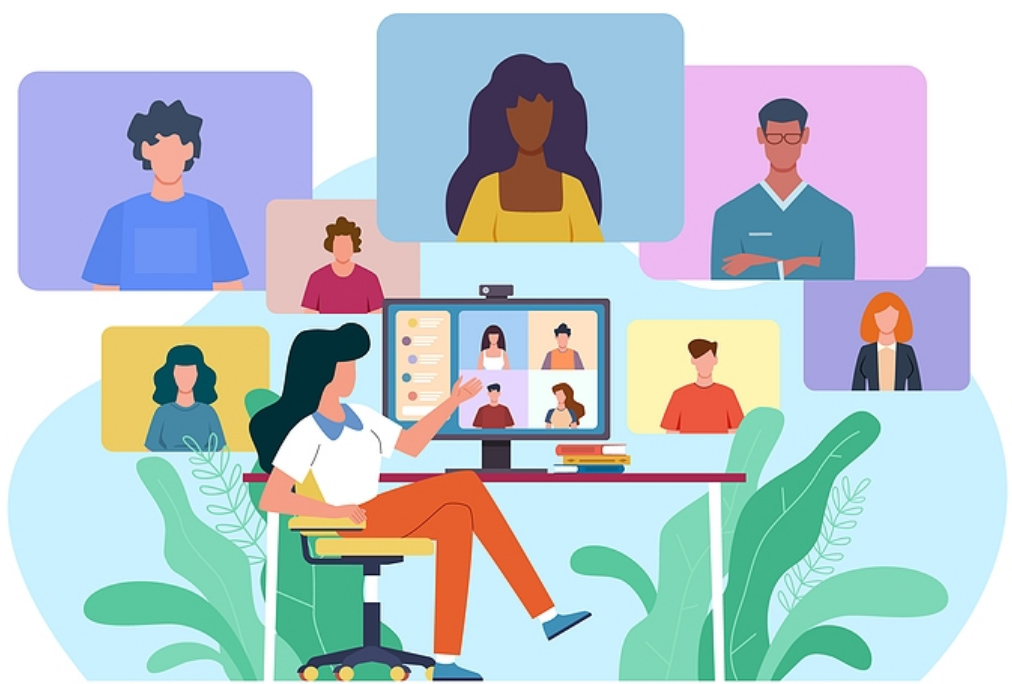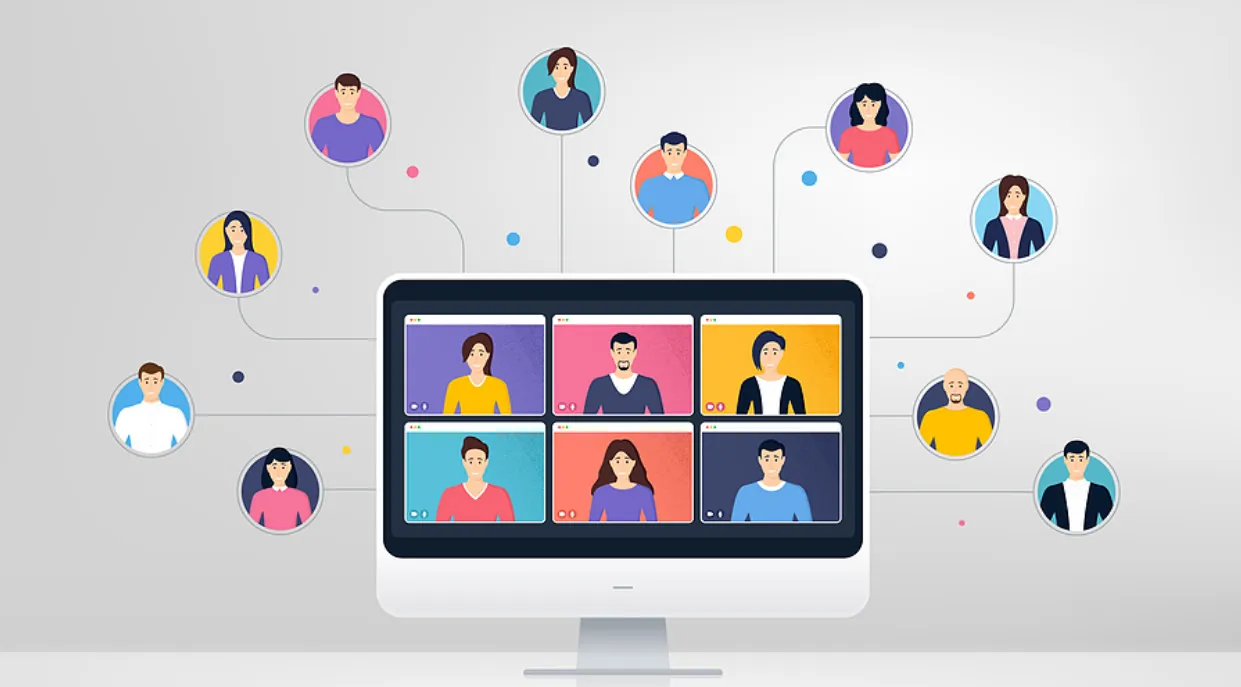
Previous forecasts showed that 98% of the corporate world would use virtual learning by 2020, and the pandemic coincidentally acted as a catalyst for this adoption. So it’s no wonder that the global eLearning Market is predicted to be worth $521.8 billion by 2027.
However, with so many different technologies and approaches available, it can be challenging to know where to start when implementing or improving a virtual learning environment (VLE). This guide will help you understand what virtual learning is, why it’s important, how it benefits learners, and how you can implement a VLE in the workplace.
What is a Virtual Learning Environment?
A virtual learning environment is educational technology that refers to any interactive online space like a virtual classroom, where learners and educators can connect. For example, it could be through a learning management system (LMS), social media platform, or even a simple video conferencing program.
VLEs may be used for synchronous or asynchronous learning, meaning they can support real-time collaboration or be accessed at any time. They also usually include a range of features and tools to support learning, such as forums, chatbots, quizzes, and gamification.
The idea of VLEs first came about in the mid-1990s when companies started creating corporate training courses for their employees. However, the concept has come a long way due to the advent of technology and online collaboration tools.
Types of Virtual Learning Environments
Typically, there are three main types of virtual learning environments. They differ in how learners and instructors interact with each other.
Synchronous
In this type of VLE, both learners and instructors are online simultaneously. They can interact with each other in real-time through features like video conferencing, chatrooms, and virtual whiteboards.
This type of learning is often used for courses that need to be completed in a certain amount of time, such as live webinars or online group projects. However, it can also be used for one-on-one tutoring sessions.
Asynchronous
An asynchronous VLE is one where learners and instructors are not online at the same time. The instructor posts materials and assignments online, and learners can access them anytime that suits them.
Asynchronous learning involves independent study and is often used for courses that don’t need to be completed in a certain amount of time. It’s also useful for learners in different time zones.
Hybrid
The third type of VLE is a mix of asynchronous and synchronous learning, called a hybrid VLE. In this learning environment, some parts of the course are completed online in real-time, while others are completed independently.
For example, a hybrid English course might involve attending live weekly video lessons and doing independent assignments in between. In such a VLE, learners can still interact with each other and their instructor, but they also have the flexibility to study at their own pace.

What is a Virtual Learning Environment Used For?
A virtual learning environment is a culmination of different elements, including learner engagement, content management, and assessment, that promote and support learning. VLEs can be used for a variety of purposes, such as:
- Deliver Course Content: A VLE can be used to host different types of content, including text, videos, infographics, and presentations. The instructors can deliver this content to learners in various ways, such as through a learning management system, social media platform, or video conferencing program.
- Support Collaborative Learning: VLEs usually include features that support collaborative learning, such as forums, chatbots, and virtual whiteboards. These features allow learners to interact with each other and their instructor in real-time, creating a more engaging and interactive learning experience.
- Facilitate Assessment: VLEs also include assessment tools, such as quizzes and surveys, to help instructors gauge learner understanding and progress. These tools can also be used to deliver feedback to learners promptly.
Besides understanding the collective function of a VLE, it’s also essential to understand how each component in the VLE functions. Instructors must know how to leverage these components to their full potential to ensure the success of the virtual learning program.

Elements of VLEs
While not all VLEs are the same, some standard elements are present in almost all virtual learning environments. Here are some of them.
Content Management
Content forms the crux of any learning program or course. Content can take on different forms in a virtual learning environment, such as text, videos, infographics, and presentations.
Instructors need to have a clear understanding of managing and delivering content in a virtual setting. They should also be aware of the different types of content in a VLE and how to make it accessible to learners.
Assessment and Curriculum
Assessing the learners is an integral part of the learning process. Assessment tools help instructors gauge learner understanding and progress. Instructors can either personalise the assessment experience for the learners or use a predefined approach.
Learner Engagement
Today, nearly 90% of businesses use eLearning content in workplace training. But how effective are these programs? The usefulness of a virtual learning program is determined by how engaged the learners are.
Instructors can use different strategies to engage learners in a VLE. These include using social media, incorporating gamification, and providing personalised content.
For instance, instructors can offer pastoral content to support learners. It can be in advice, guidance, or even just a forum to voice concerns when things get tough.
Some VLEs also offer engaging content, such as videos and infographics. Such content can help break up the monotony of text-based learning materials.
More importantly, VLEs allow instructors to make learning more accessible. For example, learners can take a step away from traditional teaching and learning methods, such as the chalkboard and whiteboard.
With a VLE, learners can control their learning environment and how they want to learn. It is especially beneficial for those with different learning styles.
Technology Infrastructure
Virtual learning environments are powered by technology. The most crucial element of any VLE is the Learning Management System (LMS). It provides the framework for delivering content, managing activities, and tracking learner progress.
An LMS is a software application that can be hosted on-premise or in the cloud. It enables instructors to create and deliver courses, track learner progress, and assess learner understanding. Some of the most popular LMSs include Blackboard, Canvas, Moodle, and Skillshub.
Communication and Collaboration Tools
Communication is necessary in any learning environment, whether face-to-face or online. In a virtual setting, communication tools help bridge the gap between instructors and learners.
These tools also allow learners to communicate with each other, fostering a sense of community and collaboration. Some of the most popular communication tools in a VLE include chat rooms, forums, blogs, and live chat.
Meanwhile, collaboration tools allow learners to work on the same document together. For example, learners may be able to edit a document, add comments, or provide feedback.

Learn How To Create Personal Learning Journeys For FREE!
What Are the Benefits of a Virtual Learning Environment?
Virtual learning environments are slowly but surely becoming popular and replacing traditional learning methods in many educational institutions and corporate settings.
Here are some advantages of virtual learning environments:
Access to Coursework
A notable problem with traditional learning methods is that learners may miss the chance to learn something if they are absent on a certain day or do not pay attention during a lesson. However, this is not the case with a virtual learning environment, which allows every learner to have uninterrupted access to the coursework at any point in the learning program.
For instance, if a learner could not attend a lesson on the day it was scheduled, they still have access to their instructors’ recorded lectures and notes. Likewise, they can participate in the program discussions in the collaboration forums.
Improved Inclusivity
Shy or introverted learners may find it difficult to participate in discussions and ask questions in a physical classroom. However, they can easily engage in the learning process by asking questions or contributing to the discussion in a virtual learning environment without feeling shy or anxious.
Similarly, disabled learners who cannot attend physical classrooms can get an education by participating in a virtual learning environment designed to be accessible for them.
Flexibility
A virtual learning environment is flexible because learners can access the learning content and materials at any time and from anywhere. Therefore, it is highly beneficial for working professionals who want to get a degree or certification while working.
Similarly, learners who have other commitments such as family or job responsibilities can also take advantage of the flexibility offered by a virtual learning environment.
Cost-Effective
Another significant advantage of a virtual learning environment is that it is cost-effective. The overhead costs of maintaining a physical classroom are eliminated in a virtual learning environment, which leads to cost savings for both learners and institutions.
Enhanced Digital Skills
Learners also adopt and enhance digital literacy skills by participating in a virtual learning environment. These skills are increasingly becoming important in the modern workplace.
For example, most jobs now require basic proficiency in computers and the internet. By participating in a virtual learning environment, learners can develop these skills and better prepare for the modern workplace.
Improved Interaction
Virtual learning environments also promote interaction between learners and instructors. The asynchronous nature of a virtual learning environment means that instructors and learners can interact with each other at any time. It is a significant advantage over traditional learning methods, often constrained by time and location.

Who Can Use Virtual Learning Environments?
Virtual learning environments are helpful for many different types of learners. For example, they can be used by students looking for a more flexible learning experience, by instructors who want to create a more interactive and engaging classroom, and by organisations that need to provide virtual training to employees.
85% of learners report a better online experience than in face-to-face classes. Meanwhile, organisations report that virtual learning takes 40% to 60% less time for their employees than traditional training methods. Thus, it helps reduce cost, save time, and ensure higher satisfaction.
Can Virtual Learning Environment Work For Corporate Teams?
According to IBM, the company’s employees learned five times more during virtual learning than traditional offline learning approaches. IBM is not the only company to have adopted virtual learning environments for its employees.
Virtual learning is becoming increasingly common in the corporate world due to the many advantages it offers over traditional offline learning methods.
Besides the organisations, employees are also more likely to be satisfied by virtual learning. For example, 95% of corporate learners choose online programs since they can learn at their own pace.
Companies can make virtual learning environments more fruitful by using additional tools and approaches, such as augmented reality, virtual reality, and certification intelligence. 23% of enterprises already use virtual reality in their learning technologies, while 11% use augmented reality.
Moreover, businesses can increase the effectiveness of virtual learning environments for teams by using microlearning. It is a principle that can be used to create engaging and bite-sized content that is easy to consume.
It has been found that microlearning can help employees retain more new information than they would remember after weeks with traditional learning methods. Research also shows microlearning to be 17% more effective than traditional teaching methods.
Quite interestingly, gamification also helps in making virtual learning more engaging. Instructors can add gaming mechanics, such as points, badges, and leaderboards, to the learning experience.
72% of employees work harder and feel more motivated if their company uses some kind of gamification. It’s not merely a personal preference by employees. Instead, it also has a scientific basis, as research shows gamification enhances learner engagement by 60%.
If businesses combine all these strategies, they can make their virtual learning environments even more effective for corporate teams. For example, they can use virtual learning environments for digital transformation, change the mindset of employees, or as a tool for succession planning.
Conclusion
In conclusion, virtual learning environments have many advantages over traditional learning methods. These advantages include flexibility, cost-effectiveness, improved inclusivity, and enhanced digital skills.
With the increasing popularity of online learning, more and more businesses are expected to adopt virtual learning environments for their employees. Businesses can see positive outcomes with their virtual learning programs by leveraging AR, VR, microlearning, and AI.
If you’re ready to level up your L&D strategy with the help of an eLearning company, get in touch with us today!













